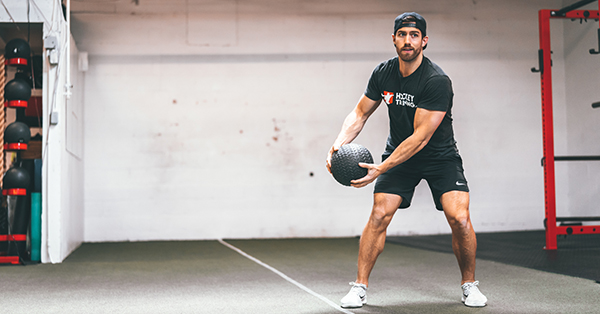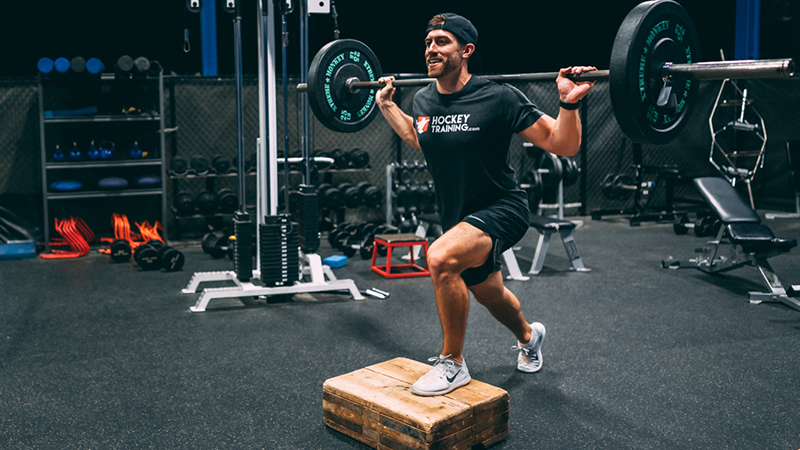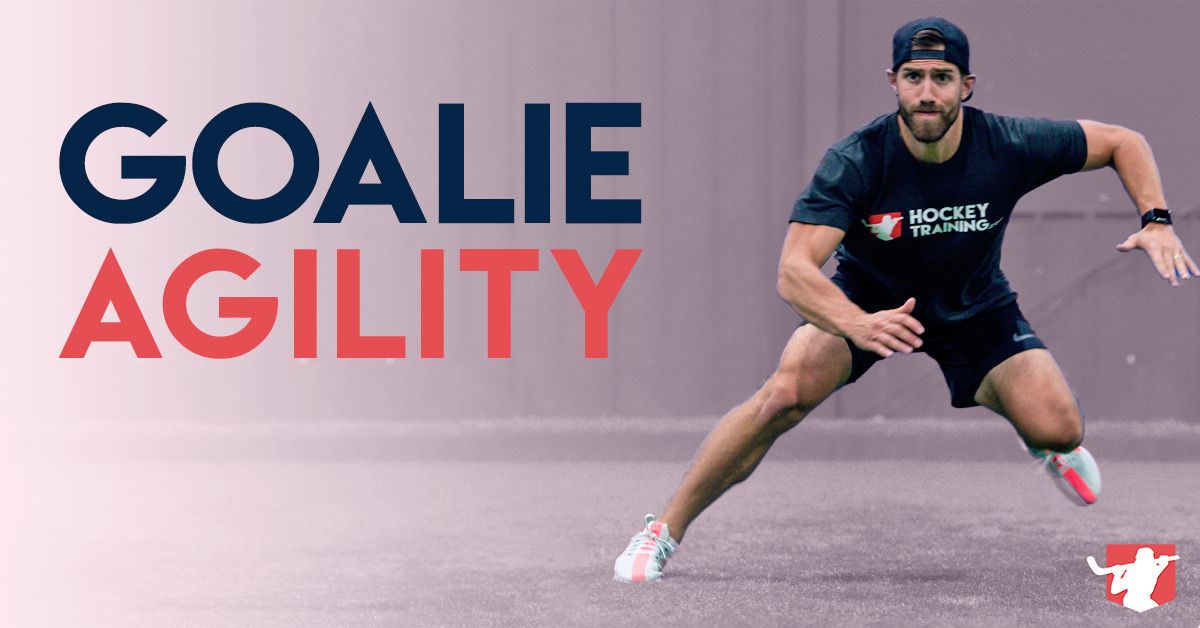In this article, I’m going to show you the exercises you need to be doing so you can be as explosive and agile as possible in between the posts.
One of the most powerful tools that you could ever have in hockey is if you are well-known as the goalie who is almost impossible to score on.
They try everything, and they can still never get by you.
Not only does this make you one of the most dominant goalies in the league, but it helps your entire team win more championships because you’re always closing the door on every opposing player who comes your way.
Very few hockey goalies work on developing their ability in this area because it is something that is very difficult to recreate in training, but, if you understand sport specific training and how the human body operates in athletic outputs – it is something that is both highly understandable and highly trainable.
When it comes to proper functional training for optimal hockey goalie performance, we have to concern ourselves with four primary movement patterns:
- Locomotion
- Changing levels
- Push/Pull
- Rotation
For the most part, if you understand these terms at an elite coaching level, this completely dominates how you create your training programs year-round to support the varying specific needs of improving skills.
We will discuss 1, 2, and 3 in the future – for now, since I want to teach you exactly what you need to do in order to start stopping more pucks by exploding from one end of the net to the other, we are going to place the focus in this article on the importance of rotation.
The Importance Behind Rotational Training for Hockey Goalies

If you want to improve your goalie specific agility, you’re going to need a couple of things:
- You’re going to need an explosive speed
- You’re going to need to be able to flawlessly change your direction at high velocities in a split second while simultaneously tracking the puck
Both of these factors rely very heavily on your ability to powerfully and effectively rotate.
Although, your rotational ability is not limited to just post-to-post explosions.
When I talk about rotation, I want you to think both “changes of direction” (which represents what most would refer to as agility) and playing the puck (think about all the rotation involved within both the upper and lower body when firing the puck up the ice to your teammates with the big goalie stick).
Rotational power and strength is arguably the most critical movement factor you could attain in the world of goalie performance.
Once you have your mobility in check, a lot of your work from that point involves understanding and properly training rotation.
It also makes up some of the replays we love the most – a huge toe save on a one-timer or exploding from one end of the net to the other when everyone thought the opposing player with the open net “had it in the bag”.
This is all rotation.
The reason why I place such a massive level of importance behind this movement pattern is that it is crucial towards power generation.
Rotational movement also “hides” in the other primary movement patterns as well.
For example, if you analyze human locomotion during skating you will quickly realize that the upper body moves in opposition to the lower body; that is, the right arm comes forward at the same time your left leg does.
If you study the glove-hand motion of a right-handed goalie, you will see the left leg and right arm move closer together just before the raise of the arm and then separate as the goalie get a high glove save.
If you study the shooting motion, a good shooter will separate the right shoulder from the left leg during the backswing and stride. Then as the hips rotate and the stick comes through the impact zone, the right shoulder comes towards the left hip.
If you have been reading very carefully, you will notice all of the similarities here between these examples:
1 – Changes of direction occur when you are at a fixed point on the ground/ice
2 – You need a dominant point of ground/ice contact (usually a single leg) in order to propel yourself in a rotational direction (for example, driving off the ice with your left skate when facing the player who you know is going to pass it to their teammate to set up a one-timer on you so you can explode in the other direction and be there before the puck is)
3 – After the initial drive from the point of ground/ice contact, all propelling movement will be driven by rotation first within the hips – and then followed up by rotation within the shoulders
4 – The pattern of ALL these is cross directional. Meaning, it is driving from left hip to right shoulder, and right hip to left shoulder (think of the opposite leg stride and arm pump during a sprint, this is cross-directional rotation movement propelling you forward)
5 – Changing direction quickly to the other side of the net requires decelerating one area of your body and immediately accelerating another area of your body in the opposite direction
6 – Your core is what bridges the gap between all of this rotational and cross-directional power and is a major key towards hockey goalie performance development
Rotational Training for Hockey Goalie Agility

From all of this discussion on the cross-directional and rotational importance on your ability to have a quick starting speed and “on the dime” change of direction ability to stop more pucks – it’s obvious that in order to properly train this in our goalie training programs we need to activate these same muscles and movement patterns.
When training these patterns, utilizing unilateral movements alone will already provide tons of rotational benefits.
This means things like single-arm presses, split squat variations, reaching lunges, single-arm rows, etc… all feature enough cross-direction (because one side is constantly stabilizing and decelerating while the other is contracting and accelerating) to provide a functional sport-specific result.
Most people don’t see that because you’re not physically rotating during the movement – but on a true biomechanical level, you are getting a highly transferable result.
You may have also seen this reported in sports science as “anti-rotation” training which is becoming a much more popular term to classify the actions happening here.
Although, if we get deeper into the training principle of specificity, you can clearly see that adding more lateral movement and more actual rotation to your training would further improve functional outputs in goalie performance.
This means working in exercises such as the mirror lateral shuffle drill, skater bounds, lateral reaching lunges, medicine rotational scoop tosses, half-kneeling lateral hops, diagonal choppers, and rotational choppers.
These will all provide a more targeted training result to make you more agile, have better explosive speed, and be able to change directions in between the pipes much faster.
Example Hockey Goalie Agility Workout
The below exercises are something you could add to any well-designed hockey goalie training program to start working the muscles and energy systems responsible for allowing you to become a brick wall out there.
Add this workout in 1-2x per week and get after it!
A1: DB lateral reaching lunges: 3 x 10 per side with 60 secs rest
A2: Lateral step-ups: 3 x 10 per side with 60 secs rest
B1: Low to high cable chop: 3 x 10 per side with 60 secs rest
B2: High to low cable chop: 3 x 10 per side with 60 secs rest
C1: Skater bounds: 3 x 4 per side with 60 secs rest
C2: Rotational medicine ball scoop toss: 3 x 4 per side with 60 secs rest
D: Palov press: 3 x 5/side with 60 secs rest
*The “A-series”, “B-series”, and “C-series” represent supersets. Perform the first exercise in the superset, rest 60 seconds, then perform the second exercise in the superset. Complete all rounds in a given superset before moving on to the next one. Lastly, perform the “D” exercise by itself in standard fashion.
Goalie Agility Wrap Up
I hope I was able to teach you something new today about hockey goalie training and how movements don’t always have to look exactly like a save in order to get a transferable effect from the gym on to the ice.
If you liked this article and want more goalie workouts to boost your physical performance, balance, coordination, and reaction time — then you have to check out the brand new In-Season Hockey Goalie Training Program.

